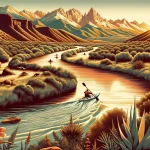Flowing 14 miles from Ruedi Reservoir in the White River National Forest to the Roaring Fork River, this tailwater fishery is home to large rainbow, brown, and cutthroat trout that eagerly rise to dry flies.
In This Article
The river’s fame stems not only from its exceptional fishing but also from its remarkable scenery. Flanked by the rugged Sawatch Mountains, the Fryingpan Valley is a serene wilderness perfect for outdoor adventures.
TL;DR
- The Fryingpan is a famous tailwater fishery below Ruedi Reservoir, known for its large trout.
- Abundant hatches like Green Drakes and Pale Morning Duns make for exceptional dry fly fishing.
- The valley offers year-round recreation like hiking, biking, skiing, and more.
Destination Overview
As a tailwater, the Fryingpan River benefits from consistent dam releases that keep water temperatures cool. This allows trout to grow very large, feeding on the abundant Mysis Shrimp and aquatic insects present in the river.
The upper stretch of the Fryingpan is known as the “Holy Water,” a special regulation section limited to catch-and-release fishing only. Monster trout over 20 inches are regularly caught here on small nymphs and midges.
Below the Holy Water, the river transitions into a freestone stream with good hatches and more public access for wade fishing. Easy wading and beautiful surroundings make this a favorite for visiting anglers.
Local Experiences and Culture
The sleepy mountain town of Basalt serves as the main gateway to the Fryingpan. Local shops and restaurants give a taste of small-town living in the Rockies, with local crafts and cuisine showcasing Colorado culture.
Area rodeos, music festivals, and farmers markets are popular attractions in the summer. Galleries and historic buildings provide cultural diversions between trips to the river.
Many local lodges and cabins accommodate visiting anglers, and locals gladly share tips on secret fishing spots.
Fly Fishing Outfitters and Guides
Due to the Fryingpan’s complex hatches and hard-to-read waters, first-time visitors would do well to hire one of the area’s experienced fishing guides.
Local outfits like Frying Pan Anglers and Taylor Creek Fly Shop offer guided wade trips, float trips, and overnight expeditions. With private access to some of the river’s best water, guides can target trophy trout with the best flies and techniques.
They also provide essential knowledge on current insect activity, proper fly selection, and how to handle the large trout. Private guided trips offer a world-class experience on this incredible fishery.
Tailwater Fishery and Ecological Insights
As a tailwater, the Fryingpan depends on consistent dam releases from Ruedi Reservoir to sustain its cold water trout habitat. Mysis Shrimp introduced into the reservoir have also contributed to the growth of massive trout.
However, this altered ecosystem has some downsides. Non-native Mysis compete with native species, while fluctuating river levels impact shoreline habitat and fish spawning areas. Careful water management and habitat improvement projects aim to mitigate these issues.
Seasonal Hatches and Fly Patterns
The Fryingpan’s diversity of aquatic bugs allows for exciting dry fly fishing when insects are hatching. Green Drakes and Pale Morning Duns kick off the summer hatch season, bringing large trout to the surface with gusto.
Later in summer, PMDs and blue-winged olives appear in tandem, requiring careful angler fly selection to match the small differences between these mayflies. Caddis and stoneflies also produce fish on emergers like Barr’s Bouface and Poxyback PMDs.
In winter, midges and annelids are the flies of choice, fished under indicators. Zebra Midges, Brassies, and small attractor patterns are produced steadily in the cold months.
Outdoor Adventures Beyond Fishing
The Fryingpan is more than just a river – it’s a gateway to Colorado’s central mountains. In summer, the valley teems with outdoor activities like road cycling, paddleboarding, and hot springs soaking along the river.
Hikers and mountain bikers flock to the Sawatch Range to enjoy wildflower meadows, alpine lakes, and peaks topping 14,000 feet. Mountaineering on the 14ers and hut-to-hut trips extend the outdoor season.
Come winter, the valley transforms into a snow-covered playground. With easy access from Basalt, cross-country skiing, snowshoeing, ice climbing, and backcountry skiing adventures abound.
Conservation and Sustainable Tourism
As a popular recreation destination, the Fryingpan sees high visitor use that threatens its fragile ecosystems. Responsible tourism practices are critical to protecting this natural wonder for future generations.
Local non-profits like the Roaring Fork Conservancy lead conservation efforts. By restoring damaged banks, monitoring water quality, and protecting shoreline habitat, they help manage the river’s health.
Anglers must follow regulations, pack out trash, and avoid spreading invasive species. By practicing catch-and-release fishing, visitors can protect the Fryingpan’s iconic trout. We all play a role in sustaining this fishery.
Planning Your Visit
To experience the Fryingpan River’s world-class fly fishing, late spring to early autumn is ideal. This maximizes dry fly opportunities during the peak hatch seasons. September still brings good streamer and nymph fishing if you are avoiding crowds. Be sure to check the Roaring Fork River Report for information on water conditions like flow and clarity and bug and fish activity.
The quaint towns of Basalt and Carbondale offer abundant lodging and dining options for home bases. Public campgrounds dot the valley for low-cost overnight stays.
Whether visiting for a weekend or an extended stay, the Fryingpan welcomes traveling anglers to test their skill against its mighty trout. Just be warned – once discovered, many find these hallowed waters calling them back year after year.
FAQ
What are the biggest trout species in the Fryingpan?
The Fryingpan is best known for its massive rainbow and brown trout, with the biggest exceeding 25 inches. Cutthroat trout also grow quite large, feeding on the river’s Mysis Shrimp.
What time of day is best for fishing the Fryingpan?
Early morning and late evening tend to be most productive during peak summer. Midday hatches can also produce. In winter, the consistent cold temps allow good nymphing all day.
Are there family-friendly activities near the Fryingpan?
Yes! In summer, tubing and paddle boards are popular with kids. Horseback riding, biking trails, hot springs, and hiking are also big family draws.
Is wading allowed in the Fryingpan River?
Most of the Fryingpan below the Holy Water section allows public wading access. Be sure to avoid trespassing onto private property marked by signage along banks.
What fishing regulations apply on the Fryingpan?
The Holy Water is strictly catch and release, while the rest of the river has a daily limit of two trout. Be sure to consult the Colorado fishing brochure for specific regulations.







